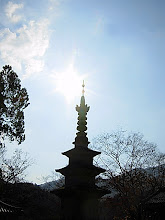One had mentioned in Part 3 that Korea was a country divided into Three Kingdoms during the 4th and 5th centuries. It is important to note that the Small Gaya Confederacy wasn't considered one of the influential three kingdoms of this period. So, what about the last kingdom of the three, the one occupying the southeast? Well, it wasn't until the 5th century that Buddhism became accepted in the Southwestern Kingdom of Shilla, one of the three kingdoms, due to the initial resistance among the royalty in that region. Nevertheless, the commoners of Korea related to the teachings of Buddhism even though the courts resisted. After a major player in the court was martyred in 527, the aristocracy of Shilla soon accepted Buddhism as the state religion.
Although Shilla sent royal envoys to China as early as 377 A.D., it wasn't until Buddhism was accepted and encouraged before thousands of Shilla monks flocked to Tang China to become educated by some of the greatest Buddhist scholars ever. The Shilla monks returned with much needed texts, statues, and other Buddhist articles. It is quite likely that at some point they started to bring back tea, something so entwined with Chinese Tang era Buddhism that it must have made it back to Korea.
The first recorded case of someone bring tea back is recorded occurred in 828 A.D. after the unification of the peninsula by the Shilla. An envoy was sent to Tang China by the King of Shilla. He sent a man, some records say he was a prominent monk, named Kim Daeryoem. Kim Daeryoem, probably realizing the importance of tea in China, devised a plot to smuggle the sacred seeds of Camellia sinensis back to his Shilla King. This was at great risk to not only himself but also the Shilla Kingdom he represented because at that time it was illegal to export tea seeds. So, after secretly acquiring the tea seeds, he unsuspectingly sewed them into the seam of his robes.
When he made it back to Korea safely, he presented his king with the seeds. The King, pleased with this gift, ordered that they be planted in an auspicious place that will encourage the best growth. After carefully searching, Kim Daeryoem decided that the seeds should be planted in a field in front of Ssanggyesa Temple, a Southern mountainside that was frequented by fog and warm, pleasant weather. A place were tea continues to grow to this day.
One is taken a back by the mystery and legend surrounding the origin of tea in Korea. As long as tea is still served in Korea, it is something that will always be lively debated. There is no debate however that wild tea bushes scatter the eerily serene mountain tops of Korea's southern mountains We debate how it got there but there is no denying that it's there.
Peace
2 days ago

No comments:
Post a Comment